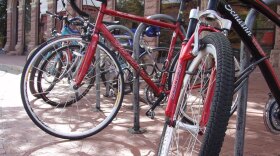Folsom Street is a north-south artery that runs through Boulder. It already has a bike lane, but in the summer of 2015, officials decided to try an experiment. On a mile-long stretch, they would try to make the street even more bike-friendly. To do this, they took away a car lane and added wider, buffered bike lanes set off from the street by white plastic posts.
The experiment was supposed to last a year, while the city collected data on changes to traffic speeds, crash data and the number of cyclists using the improved corridor. Yet after a huge public outcry, Boulder backed away from the changes less than three months in.
The anger came mostly from drivers and businesses on the corridor. They said backups and the slowing of traffic were hurting business and lengthening commutes. In response, the city decided to remove half of the new wider lanes that it just installed.
This sort of pushback is common when cities make changes that limit cars, said Andrew Goetz, a professor in the geography and environment department at the University of Denver.
"We have been so auto-oriented in our focus that the assumption is the automobile always has the right of way."

As cities try to retrofit their streets to be more multimodal, serving the needs of cyclists, pedestrians, public transportation and cars, drivers may have to be willing to experience lower levels of service in exchange, said Goetz.
"It's kind of finding a new balance within our urban areas," he said. "There are going to be these spaces within the urban areas where it's not going to be so easy to drive and that's just something I think we have to get used to."
Boulder, and probably most American cities, do not appear quite ready for this.
According to city data, peak traffic times on the corridor slowed on average by 60 to 90 seconds, so a three-and-a-half minute trip transformed into a four-and-a-half or five minute trip.
While a delay of that magnitude might not seem that significant, it can mean a driver sits through an extra light cycle, which causes frustration.

The delays also become greater at times, said Mike Gardner-Sweeney, the city's interim director of public works for transportation. On occasion, cars would be stuck in traffic three or even four minutes longer. Drivers reacted strongly, with over 1,500 strongly worded e-mails sent to city council members.
The project's goals were to increase transportation safety, slow traffic, which often flows much faster than the street's 30 mile-per-hour limit, and encourage bikers who otherwise wouldn't use the street to get out and ride, said Gardner-Sweeney.
By those measures, it was faring relatively well. Collisions were down, traffic was slowed to right around 30 miles per hour, and bike numbers were up, although this was likely more related to the onset of school than higher use, said Gardner-Sweeney.
Many drivers, however, saw things differently. Tim Blumenthal, director of People for Bikes, a Boulder-based nonprofit that works on encouraging biking and bike safety, said the level of vitriol from the community "surprised" him, coming from a city that is usually willing to experiment with new policy measures.
Blumenthal called protected bike lanes a "powerful concept" for increasing rider safety and, importantly, the feeling of safety.
Boulder's goal, like that of many cities working to improve bike transportation options, was to attract the sort of cyclist who isn't already on the street, often women and children.
The Folsom Street effort was part of a project the city calls its "Living Lab," where it experiments with different transportation configurations with the goal of making biking and walking safer in the city.
Blumenthal called the city's decision to remove half the stretch of protected bike lanes a "setback," but he also pointed to the bike meccas of Denmark and the Netherlands as examples.
.@PaulAikenBDC photos of Right Sizing bike lane demolition overnight in #boulder
— Paul Aiken (@PaulAikenBDC) October 5, 2015
see photos http://t.co/RFxj7Hl1ah pic.twitter.com/PJsEcXGpGd
"The truth was 45, 50 years ago they were building their roads and designing their streets for cars exclusively," he said.
It took a shift in goals and decades of work to transform European cities into their current bike-friendly state. If Boulder's experience is any example, the same will be true in the United States.







